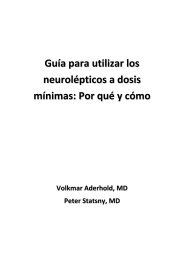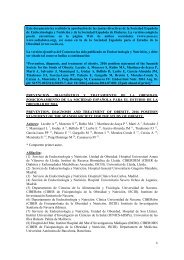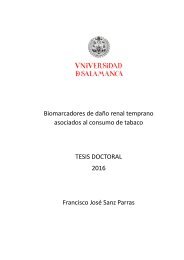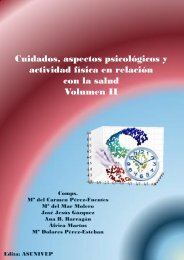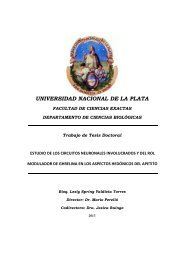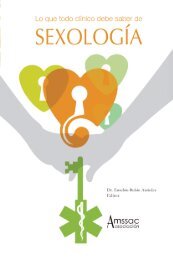Noviembre-Diciembre
156_v40n6(1)
156_v40n6(1)
Create successful ePaper yourself
Turn your PDF publications into a flip-book with our unique Google optimized e-Paper software.
Agreement between the 2009 STOPP Criteria and the 2003 Beers Criteria… Farm Hosp. 2016;40(6):504-513 - 507<br />
Discussion<br />
The total prevalence of patients with PIP in our study<br />
was of 23.8% using Beers Criteria and 33.3% with STO-<br />
PP Criteria. These values are within the wide range of<br />
15 to 79% described in literature 11-14 . The variability in<br />
prevalence may be due to different factors, such as the<br />
criteria used, the study duration, characteristics of patients<br />
and their location.<br />
Using the 2003 version of the Beers Criteria, the value<br />
of prevalence detected in hospitals has been found<br />
to be similar to the one described in literature, ranging<br />
between 14 and 44% 14-16 . In other levels of chronic patient<br />
care, such as Primary Care, this value usually ranges<br />
between 18 and 42% 17-22 .<br />
The prevalence of patients with PIP detected by the<br />
STOPP Criteria lies within the range detected by other<br />
authors at hospital level, ranging between 25.4 and<br />
51.3% 13,23-26 . In Primary Care, there is no such disparity<br />
between the outcomes of different studies, and the prevalence<br />
of PIPs detected by STOPP Criteria usually ranges<br />
between 32 and 51.4% 11 .<br />
Though some studies have been conducted with<br />
the aim of comparing both the STOPP Criteria and the<br />
Beers Criteria, so far there has been no analysis of the<br />
level of agreement with the Kappa Coefficient. In our<br />
study, the low level agreement shown through this coefficient<br />
among patients with PIPs detected according<br />
to Beers Criteria and STOPP Criteria could be due to<br />
different reasons. First of all, the drugs considered in<br />
each set of criteria are different; STOPP Criteria take<br />
into account the relationship of drug-drug interaction<br />
or duplication, and contain 33 situations of PIP detection<br />
with clinical relevance, not found in the 2003 version<br />
of Beers Criteria. Even so, 1.7% of the PIPs detected<br />
that were identified by STOPP Criteria were not<br />
identified by Beers Criteria; the main ones are the use<br />
of loop diuretics for malleolar oedemas without heart<br />
failure (STOPP A2), and the use of neuroleptic drugs as<br />
hypnotic agents outside delirium or for patients with<br />
frequent falls (STOPP B8).<br />
However, the greatest difference seems to lie in the<br />
availability of drugs in the formulary of each country. In<br />
our hospital, besides the 30 drugs included in the Beers<br />
Criteria which are not marketed in Spain, 31 drugs of<br />
those included in the Beers lists are not included in the<br />
Hospital Formulary, vs. one single drug in the STOPP Criteria<br />
which is not included (dipyridamole) 5-6 . Finally, the<br />
Beers Criteria were developed for non-hospitalized patients,<br />
and therefore PIP detection could be less relevant<br />
in hospitalized patients 5-6 .<br />
Among all the prescriptions for individual medications<br />
that were analyzed, 5.1% were detected according to<br />
Beers Criteria and 6.8% according to STOPP Criteria,<br />
which means that the latter detect 33% more PIPs than<br />
the former.<br />
Among older patients, psychotropics and antihistamines<br />
are two pharmacological groups with special relevance<br />
among older patients, since they are frequently<br />
prescribed inadequately and are associated with a high<br />
number of adverse reactions. It is worth pointing out<br />
that in our study, unlike the outcomes for overall drug,<br />
Beers Criteria showed a higher ability for detecting problems<br />
associated with psychotropics and antihistamines<br />
than STOPP Criteria did.<br />
First-generation antihistamines are difficult to manage<br />
in elderly patients due to their undesirable anticholinergic<br />
effects and potential toxicity. Without including<br />
those PIPs detected in patients who had suffered from<br />
previous falls, these represented a 16.8% of PIP detection<br />
according to Beers Criteria vs. a 2.4% according to<br />
STOPP. The reason for this difference is that STOPP only<br />
classifies their prolonged term as a PIP, while the Beers<br />
Criteria will detect PIP regardless of the time of use.<br />
However, these outcomes were slightly superior to those<br />
found by other authors also at hospital level, with values<br />
ranging between 0.3 and 2.7% by applying the STOPP<br />
Criteria, and 1.8% according to Beers 12,16,21 . The outcomes<br />
obtained could be explained by a high use of the<br />
antihistamine hydroxyzine as an antipruritic agent, with<br />
a deep sedative effect, which was positioned among the<br />
10 drugs with the highest number of associated PIPs according<br />
to both types of criteria.<br />
Tricyclic antidepressants are no longer first-line drugs<br />
for elderly people due to their high potential of causing<br />
adverse effects. However, these drugs are still frequently<br />
prescribed. In our study, these drugs represented 7.7 and<br />
2.9% of PIPs detected by the Beers and STOPP Criteria,<br />
respectively, being quite similar to the results found by<br />
other authors whose PIPs for this group range between<br />
7.1 and 7.7%, according to Beers Criteria, and between<br />
1.5 and 4.1% according to STOPP 12,16,20 . The reason for<br />
this difference in prevalence is that Beers Criteria contraindicate<br />
the use of tricyclic antidepressants per se (doxepin,<br />
amitriptyline and imipramine) regardless of diagnosis<br />
and clinical setting, whereas the STOPP Criteria only<br />
state certain scenarios in which these drugs should not<br />
be used (dementia, glaucoma, altered cardiac conduction<br />
and constipation), being therefore more flexible and<br />
allowing a higher selection in prescription 5 .<br />
Regarding benzodiazepines, frequently included in<br />
the studies about PIP prevalence 27 ,detection rates were<br />
different between the Beers and the STOPP Criteria, of<br />
11 and 5.3% respectively. In our study, the reason for<br />
this difference in the detection rates between both criteria<br />
is that STOPP only detected as inappropriate the<br />
prolonged use of long half-life benzodiazepines, unlike<br />
Beers Criteria, which also considered short-acting benzodiazepines.<br />
Values in other studies fall between 2.7<br />
and 23.9% according to Beers Criteria, and between<br />
5.1 and 20.4% when using the STOPP Criteria, in agreement<br />
with our outcomes 12,14,16,25,28-30 .




